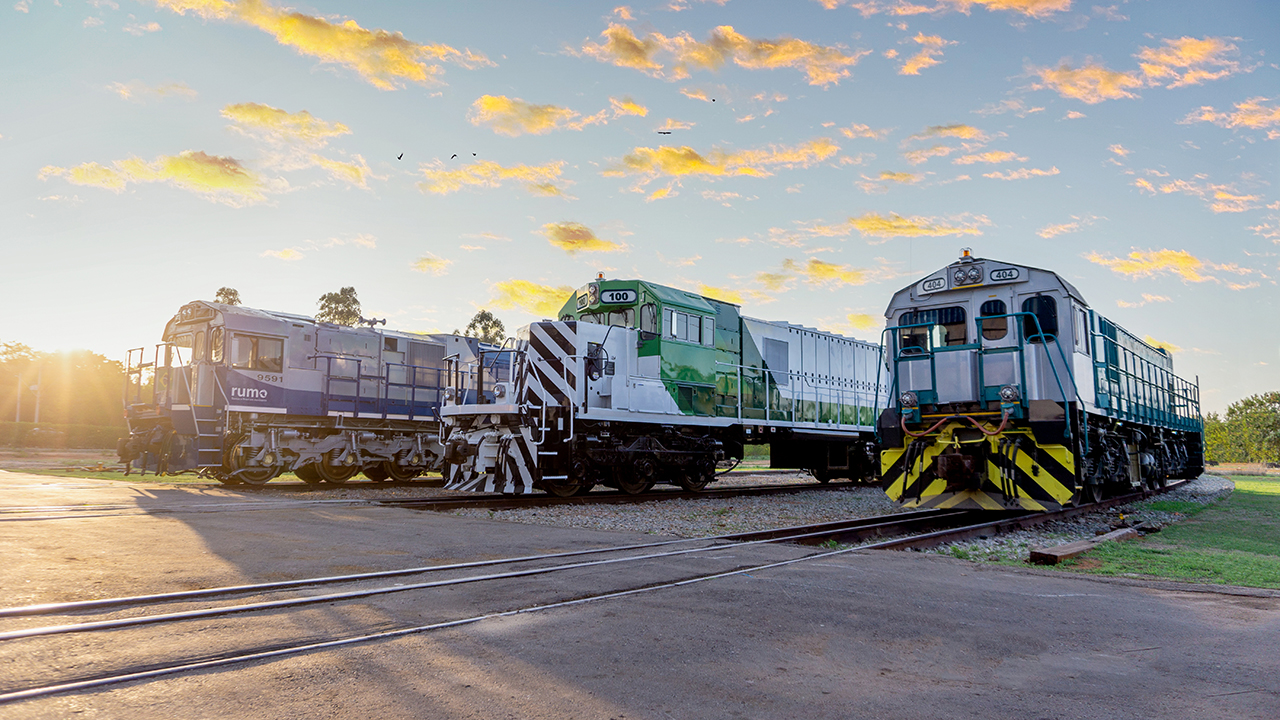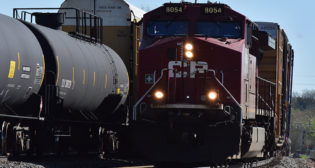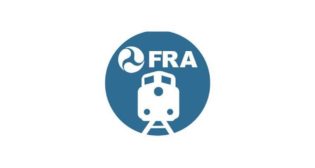
ZE Energy Sources for Locomotives
Written by Alex Luvishis, Ph.D
Left to right: Progress Rail EMD® GT38H hybrid, SD40JR Joule battery-electric, and GT38JC Joule. Progress Rail photo
First, let’s look at the release of harmful substances by locomotives with onboard energy sources. The most prominent is the diesel-electric locomotive. Its electric traction motors are environmentally friendly, but its diesel engine releases harmful substances. An electric locomotive has an environmentally friendly traction drive, but if we want to determine the environmental friendliness of both the traction drive and the energy source, the answer is not so clear.
An electric locomotive’s energy source is a contact network, which consists of a power plant, and line power transmission from a power station to traction substations to catenary or third rail. From all parts of the circuit described above, only the power plant may or may not release harmful substances. If it is a hydroelectric, wind or solar station or a nuclear power plant (except for disposal of spent fuel rods), then it is a zero-emission (ZE) source of energy, and the electric locomotive is completely environmentally friendly. If it is a thermal power plant that burns fossil fuel (coal, oil, natural gas), it emits harmful substances, so the electric locomotive powered by this station is not completely ZE.
An exception is a battery-electric locomotive. Both the traction drive and energy source are environmentally friendly, but a battery-electric locomotive is ZE only if the batteries are charged from an environmentally friendly source.
In the 21st century, the situation has changed. Modern diesel-electric locomotives meeting EPA Tier 2, 3 and 4 emissions standards are much more sustainable than older units. Battery-electric and HFC (hydrogen fuel cell) locomotives are gradually evolving from the experimental stage, but they are few in number.
Newer battery-electric locomotives use rechargeable batteries significantly superior to those of early units, and their traction motors are also more energy efficient. The batteries of these locomotives require external recharging, so again, a battery-electric locomotive is ZE only if the batteries are charged from an environmentally friendly source. HFC locomotives are completely environmentally friendly if the hydrogen used is obtained using an electrolyzer powered by electricity from an environmentally friendly source.
The world’s top-five producers of carbon dioxide, percentage-wise, are:
- China: 32.93%
- United States: 12.55%
- European Union: 7.33%
- India: 7%
- Russia: 5.13%
Together, they account for about 65% of global CO2 emissions.The rapid development of renewable energy sources like solar and wind stations has been facilitated by new technological capabilities. Interestingly, the U.S. is ranked second globally in both solar and wind power capacity.
There are two types of solar power:
- Concentrated Solar Power (CSP) systems, which convert solar energy into electricity using various mirror configurations that concentrate energy for use in a heat engine, usually a steam turbine. The heat engine’s mechanical energy output is converted into electricity by generators.
- Photovoltaic (PV) solar power systems, which convert solar energy directly into electricity.
Solar Star is a five-square-mile) PV power plant owned and operated by SunPower Services with a 579 MW capacity. Located near Rosamond, Calif., it opened in 2015. Solar Star contains 1.7 million solar panels produced by SunPower. In addition to solar panels, the station includes inverters converting the DC output of the solar panels to AC transmission power. Specialized equipment that tracks the angle between the solar panels and the sun. Power output depends on the angle between the solar panels and the sun. As the sun moves in the sky, the panels rotate, boosting output approximately 25% higher than stations with stationery panels. In 2015, Solar Star was the most powerful solar station in the world. Now it is ranked 15th, but its solar panels have the highest efficiency and specific power (0.58 GW per 12 square km).
Wind farms convert the kinetic energy of wind into electrical energy. The most powerful wind farm in the U.S. is Alta Wind Energy Center, located in Tehachapi Pass in the Tehachapi Mountains, Kern County, Calif. Occupying 81 square miles, its 600 wind turbines have a power output of 1,550 MW.
Wind turbines consist of a mast, rotor (blades and hub), rotor shaft, gearbox and generator, which converts mechanical rotational energy into electricity. The most powerful wind turbine in the U.S. is General Electric’s 14-MW-capacity Haliade-X offshore turbine, with a mast height of 722 feet and a blade length of 351 feet.
Emergence of 100% ZE Railways
Following are several railways that can claim 100% ZE:
- The Tokyo region has seven commuter rail lines and one light rail line powered by sources that do not emit harmful substances. This applies to all rolling stock and stations.
- All Netherlands Railways electric trains use power from wind farms. About 600,000 passengers travel every day on these trains.
- Austrian Railways (ÖBB) currently owns nine hydroelectric power plants that jointly generate about 750 GWh of electricity. In addition to hydropower, ÖBB is increasing the capacity of its solar and wind power plants. ÖBB intends now to generate an additional 230 GWh from hydroelectric power plants, wind turbines and solar stations The 45 solar stations currently in use already produce 10 GWh. ÖBB has been using 100% green energy for traction power since 2018, one-third of which is produced by its eight owned hydroelectric plants. The other two-thirds are generated by solar and wind. A solar power plant was built for traction purposes in Wilfleinsdorf, Lower Austria. The first wind farm for such purpose was built in Höflein, Lower Austria. Current is supplied directly into the catenary network, with low losses.
Export/Import of Renewable Energy
Chile could become an important exporter of solar energy. The country’s plans are tied to the 210 MW Cerro Dominador Solar Power Plant, a hybrid CSP/PV station in the Atacama Desert, one of the driest places on earth, with the highest solar radiation. According to the Chilean Solar Energy Association (ACESOL), in 2020 the Chilean government announced the “Antípodas Project,” a plan to lay a submarine cable along the bottom of the Pacific Ocean for export of solar energy from South America to China. According to Chilean President Sebastian Piñera, his country will be able to supply between 200 and 600 GW annually of electricity. Cable length will be 9,300 miles; its cost is estimated at $2 billion.
The world’s second-largest exporter of renewable energy could be Morocco, which has installed Africa’s most powerful wind turbines and solar stations. The Tarfaya wind farm, consisting of 131 wind turbines with a capacity of 2.3 MW each providing total station power of 300 MW, is the most powerful. The station complex, which occupies more than 60 square miles, is located 12 miles from the city of Tarfaya.
Built on an area of almost 12 square miles, Morroco’s Ouarzazate Solar Power Station, also called Noor Power Station, located six miles from the city of Ouarzazate, is the world’s largest CSP station with a capacity of 510 MW.
Britain has a plan to build a subsea cable carrying renewable energy from Morocco as a project of “national significance.” The Xlinks Morocco-UK Power Project proposes creation of a 2,400-mile cable passing close to Portugal, Spain and France that would supply 10.5 GW of renewable generation, with 20 GWh of battery storage and a 3.6 GW high-voltage direct current interconnector to carry solar and wind-generated electricity. If built, the cable would supply up to 7.5% of Britain’s electricity consumption. The first phase of the $25 billion project is expected to be operational in 2029, with the second phase due in 2031.
These subsea cable projects are very ambitious, and their implementation in the foreseeable future looks doubtful. However, they do not seem completely unfeasible. Today in Europe, many ultra-high voltage (UPV) cables for energy transmission are in use. There are also many such cables in China, where in 2018, construction of more than 2,400 miles of UPV carrying 1,100 kV DC was completed. Australia plans to complete construction in 2027 of a 2,400-mile UPV cable for transmission of large quantities of renewable energy to Hong Kong.
Consider this: More than 100 years ago, at the beginning of the 20th century, even science fiction writers could not imagine that by the end of the century, high-speed trains would regularly carry passengers under the English Channel.

Alex Luvishis, Ph.D. for 18 years headed the laboratory that developed control systems for Russia’s first electric locomotives and asynchronous traction motors in the former USSR. For a further seven years, he headed the rolling stock department at the Institute of Technical Information of Railway Transport in Moscow. Dr. Luvishis is the author of more than 100 articles on electric traction drives and the book “Hybrid Rail Vehicles,” published in 2009. His interests are asynchronous traction drive systems for modern rolling stock, and hybrid drive systems for trams, suburban and regional trains and switching and main line locomotives. He has lived in the U.S. since 1999.



